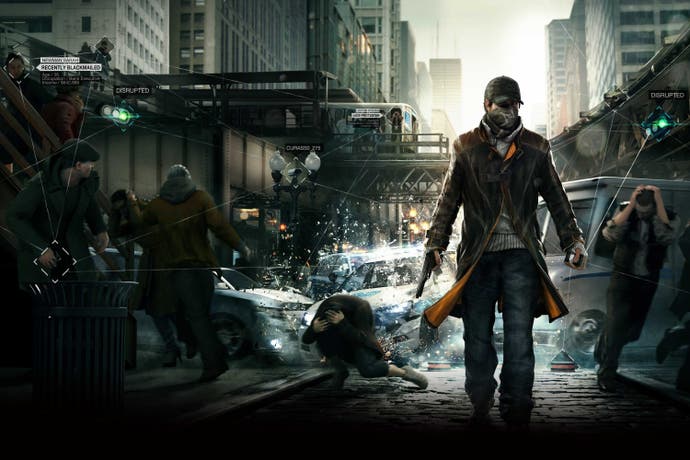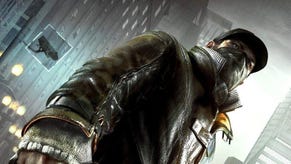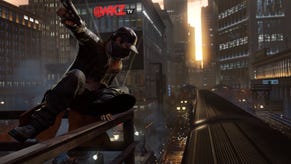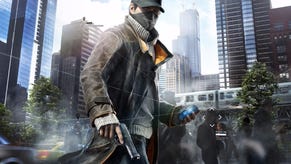Does Watch Dogs deliver on its early promise?
Pearce de résistance.
There's something about Watch Dogs' recent graphics debate that goes beyond skin deep. Games evolve between conception, unveiling and release - and after a five-year development it should be no surprise that things have changed. It sounds like there's now good news in the graphics department, but it remains to be seen whether the vocal minority that felt disappointed will have been won back. It wasn't simply that the game might look worse - rightly or wrongly, those players felt Ubisoft had cheated on a key part of the vision sold back at Watch Dogs' E3 2012 unveiling.
A part of that promise was a game in which you could control everything - where an entire city was at your fingertips, and the population's darkest secrets were there to exploit. It was a tantalising concept. Not only did the slice of gameplay shown tease a visually exciting next-gen open world, but the complexity of that world seemed a step beyond what we were used to. It was a virtual city where the population were apparently more than just polygons on a pavement, where they became believable inhabitants of a virtual Chicago whose lives you could delve into and even destroy - all at the click of a button.
How much this will still ring true for you in the final game depends on how deeply you become invested in the Watch Dogs brand of hacker fantasy. Of course you can't control everything and of course there are limits. Far from doing any actual hacking, much of the time you're just pressing a button to activate abilities or bring up auto-generated blurbs on passers-by. And, after an extended period of creating car crashes at the touch of a button, that same action can quickly become just that - a win button. Give it a tap and you're racing away.
But, put together and executed correctly, Aiden Pearce's arsenal can be devastatingly effective. Armed with Splinter Cell-style gadgetry, you'll black out lights to blind foes, remotely explode an enemy's stock of grenades, activate car alarms or set nearby machinery whirring to cause distractions. These tools are fun to play around with by yourself in the game's open world but are best put to use in controlled areas where you can feel that a hand has designed several paths for you to follow - zooming between CCTV cameras to remotely hack objects and cause confusion when infiltrating one of the city's CTOS control points, for example, as opposed to going in on foot and dealing with the guards in person.
The game's single-player campaign offers numerous scenarios to flex your skills in tightly-controlled environments, although main character Aiden Pearce begins the game with only the most basic of tools downloaded to his shiny phone. (The beginning of Pearce's story has been detailed before elsewhere, but for those wary of spoilers, feel free to skip the rest of this paragraph.) Watch Dogs opens with Pearce embroiled in a heist spiralling out of control, and a slip-up that sees his six-year-old niece killed in retaliation for his crime. Fast forward nearly a year and Pearce is now obsessed with tracking down those responsible.
Of course you can't control everything and of course there are limits. Far from doing any actual hacking, much of the time you're just pressing a button.
Taking control of Pearce inside the locker room at Chicago's iconic Wrigley Field baseball stadium, the game's tutorial level sees you begin to incapacitate and distract with ease. Pearce is happy to entangle nearby gang members with cops for the sake of a distraction and put a packed stand full of people in jeopardy with a neat set-piece that shows off one of his tech abilities released at large. This end of level trick is an atmospheric example of the game's attempts to draw you into its hacker fantasy, but it's cheapened a little by the fact you're stuck behind glass, only able to watch the panic unfolding from the other side.
After a set of introductory missions the game opens up, happy to give you room to play with your widening arsenal of weaponry and powers. One standout level sees Pearce infiltrate a factory only to be told that the location is a set-up - he only has two minutes to prepare until enemies arrive. Suddenly the game switches into tower defence mode, with a newly-acquired set of sticky bombs its star. A timer ticks down as you rush about the factory floor laying traps near choke points and removing potential enemy cover before climbing up to a crane - manoeuvrable via your phone - for a bird's eye view of the scene below. From up here you can remotely detonate your charges at specific times, throw down grenades and snipe any survivors. Missions like these leave you in no doubt at the fun to be found in Watch Dog's open world.
And you'll be exploring it a while if you want to see the game through to the end. The average playthrough clocks in at around 35-40 hours, creative director Jonathan Morin told Eurogamer, but you'll need somewhere beyond 100 hours to see everything on offer. It's not an unbelievable figure - there is an astonishing amount of side-content to tempt you away from the main campaign, although you may not feel the need to see it all. Drive a block and you'll find dynamically-generated side-missions popping up starring NPCs in trouble. The first of these is a mandatory affair near the game's start, designed to introduce you to the concept that you can automatically profile pedestrians nearby to determine who might be a threat, and, a little oddly, who might be a victim. Thankfully there are plenty more combinations beyond the "save the girl" trope although this is, a little sadly, your first mission of this type.
There's so much to see and do it's a little overwhelming, and while some mission types fit smoothly others feel superfluous.
Already revealed are the AR games accessible via Pearce's mobile phone that overlay glyphs to collect or alien-spawning portals to fight over the regular Chicago cityscape. Newly divulged, however, are the more robust mini-games, termed Digital Trips, which transform Watch Dogs' world with supernatural or sci-fi elements. They're like miniature versions of the wacky Far Cry 3: Blood Dragon spin-off, but already existing within the main game.
Load up 'Madness' and you're tasked with running down groups of Ghost Rider-style enemies, charging over them in your vehicle and pulling doughnuts over large groups. Then there's 'Spider Tank', which gifts you control of a mecha arachnid armed with machine guns, rockets and claws to squish pedestrians and traffic alike in your grip. Your eight-legged tank can climb any surface - the side of a skyscraper, or the underside of a bridge - and jump vast distances to drop death from above. Both mini-games have their own individual skill-trees of upgrades to unlock, too. Ridiculous.
There's so much to see and do it's a little overwhelming, in fact, and while some mission types fit smoothly within the game (you can raid gang hideouts, undertake races on land and sea, even leave items for other players at city hotspots), others feel superfluous - did we really need another set of pub games, or the ability to play a round of chess? It's not quite the barrel-making bloat of Assassin's Creed 3, although you can't help but wonder if the work to throw in the kitchen sideboard as well as the sink could have been better spent elsewhere.
More worthwhile, though, are the game's suite of seamless multiplayer modes, some of which are at least as fun as most of the main campaign. I've written before about how I think these online offerings are Watch Dogs' secret weapon - a set of ways to interact with friends and other random players across the dense Chicago cityscape. Ubisoft has shown off some of these before, such as the cat-and-mouse hacking mode where you're suddenly alerted to the fact that another human player is in your game, hiding close-by, and siphoning data from your phone. It's still a thrill to see that message pop up and the chase begin.
It's not a case of quantity over quality, but a question of whether the game ultimately delivers on its promise of a new kind of open world.
Online races are pretty self-explanatory - these are the least dynamic of the modes with fixed start and end points, and menus in-between races to vote on the next route for your party to race. Much more fun is the Decryption mode, where players must hold onto a file for a certain length of time. It can be played between various players or across two sides, which leaves you facing small armies of cars and players armed with explosives - or vice versa, with a wake of friendlies protecting you as you speed off holding the goods. The game's tablet mode was sadly not yet available to try, but I was shown how it will work in video form - it will allow someone armed with the game's iOS/Android companion app to drop in your game to help or hinder you on specific missions, armed with a lo-fi, top-down map of your surroundings and a stock of cop cars and helicopters to play with. Then there's the no-rules free-roam mode, a "bonus feature" according to Morin, where the only option on offer is a simple ability to flag whether players are friends or foes.
The playground Ubisoft Montreal has crafted is certainly impressive - in single-player, in side content and online - and yet you could still question whether all of this work has gone into the right areas. It's not a case of quantity over quality, but a question of whether the game ultimately delivers on its promise of a new kind of open world, a place that wears the label of 'next-gen' for achieving more than shinier graphics and simple tricks to manipulate your environment. I don't think Ubisoft cheats on providing its version of this - it's just that the company's original vision for Watch Dogs' city and its populace is still there for pursuing.
This article is based on a press trip to Paris. Ubisoft paid for travel and accommodation. Ubisoft also gave asset bags to journalists that contained a Nexus 7 tablet that we have donated to charity in accordance with our public policies. Check out this comment from our editor for more details.















.png?width=291&height=164&fit=crop&quality=80&format=jpg&auto=webp)



